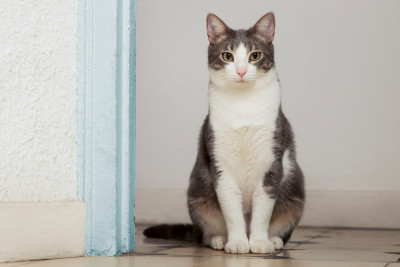Start Early with Kittens
If you've adopted a kitten, it's essential to start training and socialization early. Kittens are like sponges, soaking up experiences and learning from their environment. Begin by:
-
Handling: Gently handle your kitten from a young age to get them accustomed to human touch and build trust.
-
Positive Play: Use interactive toys to engage in positive playtime, stimulating their physical and mental development.
-
Litter Box Training: Introduce the litter box promptly and ensure it's easily accessible.
-
Socialization: Expose your kitten to various people, places, and sounds to prevent fearfulness in adulthood.
2. Establish a Safe and Comfortable Environment
Create a safe and comfortable environment for your cat to thrive. This includes:
-
Designated Space: Set up a designated space with bedding, food, water, and a litter box.
-
Scratching Posts: Provide scratching posts and toys to satisfy their natural instincts.
-
Hide Cords and Hazards: Cat-proof your home by hiding cords and removing potential hazards.
3. Positive Reinforcement Training
Positive reinforcement is the most effective training method for cats. Reward good behavior with treats, praise, and affection. Here are some training tips:
-
Basic Commands: Teach basic commands like "sit," "stay," and "come" using treats as incentives.
-
Clicker Training: Clicker training can be effective for shaping desired behaviors.
-
Litter Box Training: If your cat is struggling with litter box training, use positive reinforcement and avoid punishment.
4. Behavior Correction
Address unwanted behaviors with patience and consistency:
-
Scratching Furniture: Provide alternative scratching posts and use deterrents on furniture.
-
Inappropriate Elimination: Identify the cause of litter box issues, such as health problems or environmental stress.
-
Aggression: Consult with a professional if your cat displays aggressive behavior.
5. Socializing Adult Cats
Socializing adult cats, especially rescues or strays, may require extra time and patience:
-
Quiet Introduction: Introduce your new cat to their surroundings gradually, starting in a quiet room.
-
Slow Integration: Gradually introduce your new cat to other pets in the household in a controlled manner.
-
Bonding Time: Spend quality bonding time with your cat through grooming and play.
6. Understand Body Language
To effectively socialize your cat, it's crucial to understand feline body language:
-
Tail Position: A relaxed tail indicates contentment, while a puffed-up tail may signify fear or aggression.
-
Purring: Purring doesn't always indicate happiness; it can also be a sign of distress.
-
Ears and Eyes: Forward-facing ears and soft eyes typically indicate a relaxed cat, while flattened ears or dilated pupils may indicate fear or aggression.
7. Health and Wellness
Maintaining your cat's health is essential for their behavior and overall well-being:
-
Regular Vet Visits: Schedule regular vet check-ups to monitor your cat's health and address any medical issues promptly.
-
Proper Nutrition: Provide a balanced diet appropriate for your cat's age and health status.
-
Exercise and Mental Stimulation: Engage your cat in play and provide mental stimulation to prevent boredom and behavioral problems.
8. Patience and Consistency
Training and socialization take time. Be patient and consistent in your efforts. Celebrate small victories and remain calm when facing challenges.
Conclusion
Training and socializing your new feline friend is a journey that strengthens your bond and enhances your cat's quality of life. Whether you're welcoming a kitten or an adult cat into your home, positive reinforcement, patience, and understanding of feline behavior are the keys to success. By creating a safe and loving environment, teaching desired behaviors, and addressing any challenges with care, you'll ensure that your cat becomes a well-adjusted and cherished member of your family. Remember that every cat is unique, and with dedication and empathy, you can help your feline friend thrive and enjoy a fulfilling life by your side.







